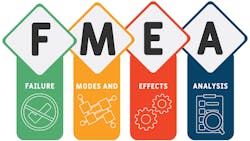Are your FMEAs focused on the asset or plant level?
The role of continuous improvement in a manufacturing plant is to identify and implement changes to improve the production process's efficiency, quality, and safety. This may involve identifying and addressing bottlenecks, streamlining processes, and implementing new technology or techniques to increase productivity and reduce waste. Continuous improvement can also help you reduce costs and stay competitive in the market.
The plant's management team may lead ongoing improvement initiatives, but they should involve input and participation from all levels of the organization. Tools like root cause analysis, process mapping, and determining maintenance strategies using reliability-centered maintenance approaches come into play. Some of these approaches can require the plants to commit to longer-term investments, either in time or resources. Both are in short supply for plant managers, who are measured on this month’s or quarter’s results; these pressures can be compounded by supply chain shortages that make it more challenging to meet the business targets.
The challenge is for maintenance and reliability professionals to think more like business owners, more holistically and proactively. Rather than waiting for equipment failure to drive root cause efforts (if the impact is significant enough to meet the incident reporting criteria), you should be leveraging tools to prioritize efforts to reduce downtime, delays, or other factors that impact the business objectives. For most, that process starts with the question, “what keeps the site or a production line from getting product out the door to the customer, on time, right the first time from a quality perspective, and at the right cost?”
Through his books and teachings, Ron Moore has been a great resource on my reliability journey. Moore taught me to leverage failure modes and effects analysis (FMEA) to prioritize continuous improvement activities beyond the individual asset. Initially, however, I learned to apply FMEA for equipment failure from another author, Keith Mobley.
In my plant, we needed help to determine the methods to improve the reliability of a caramel cooker. Mobley led the initial FMEA analysis. While maintenance had opportunities to improve, real revelations came in how production operated the equipment. Our team learned that most failures of that cooker came from improper operation and clean-in-place (CIP) activities. Using FMEA for individual assets is the typical approach if used at all.
In contrast, rather than using FMEA at the asset level, Moore taught me to leverage the tool at a higher level, at the line or plant level, answering the question framed above. Answers to that question in the analysis are used to identify actions and prioritize them based on the business impact and difficulty
Having leveraged FMEA at the line level numerous times with clients, here is the approach.
- Determine the plant, production line, or system with multiple assets. We will focus on the production line level for the remainder of the article. Start with the line causing the most issues impacting the business.
- Understand the software tool that you will use. If necessary, develop a spreadsheet that enables you to capture the analysis. The categories for a production line-level FMEA are different. Consider the headings of the item number, failure mode or issue, frequency, effects or consequences, quantified impact, cost, cases lost per event, annualized total effects, and difficulty to fix rating for the initial analysis. Add the action items, priority, desired completion date, and responsible party for the actions portion.
- Identify a cross-functional team of operators, maintainers, quality techs, and supervisors as an example. You may want to include safety, engineering, quality, or others where necessary.
- Facilitate the analysis meetings in four-hour blocks. A typical line-level analysis can be completed in a few days of four-hour blocks.
- Using a four-quadrant chart, map the items with one axis being “degree of difficulty” and the other axis being “impact in dollars or cases,” depending which one the team has standardized on. The chart will help the team decide on which items to take action.
- Rank the items and action them.
Likely, items from the analysis will surprise people in the room. Raw or packaging logistics may consistently delay production startups. A lack of shipping trucks may force the line down when warehouse space does not exist to put the finished product requiring shutdowns or delays. Human Resources may take too long to fill open positions, then temporary personnel fill the empty operator slots without training, causing improper operation and downtime. Engineering may be required for reengineering specific asset functionality. And maintenance may have issues to address as well.
In the spirit of continuous improvement, revisit the analysis at least every eighteen months. What has changed? New issues will crop up, and the business requirements may also vary.
From the Plant Floor
From the Plant Floor is a new monthly column that explores reliability challenges faced by organizations and solutions to overcome them.
About the Author
Jeff Shiver
Founder and managing principal at People and Processes, Inc.
Jeff Shiver CMRP is a founder and managing principal at People and Processes, Inc. Jeff guides people to achieve success in maintenance and reliability practices using common sense approaches. Visit his website www.PeopleandProcesses.com, and contact him on LinkedIn at www.linkedin.com/in/jeffshiver or via email at [email protected].

